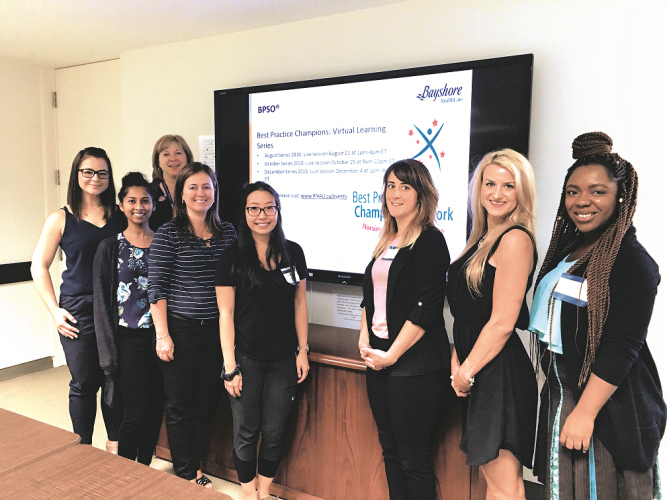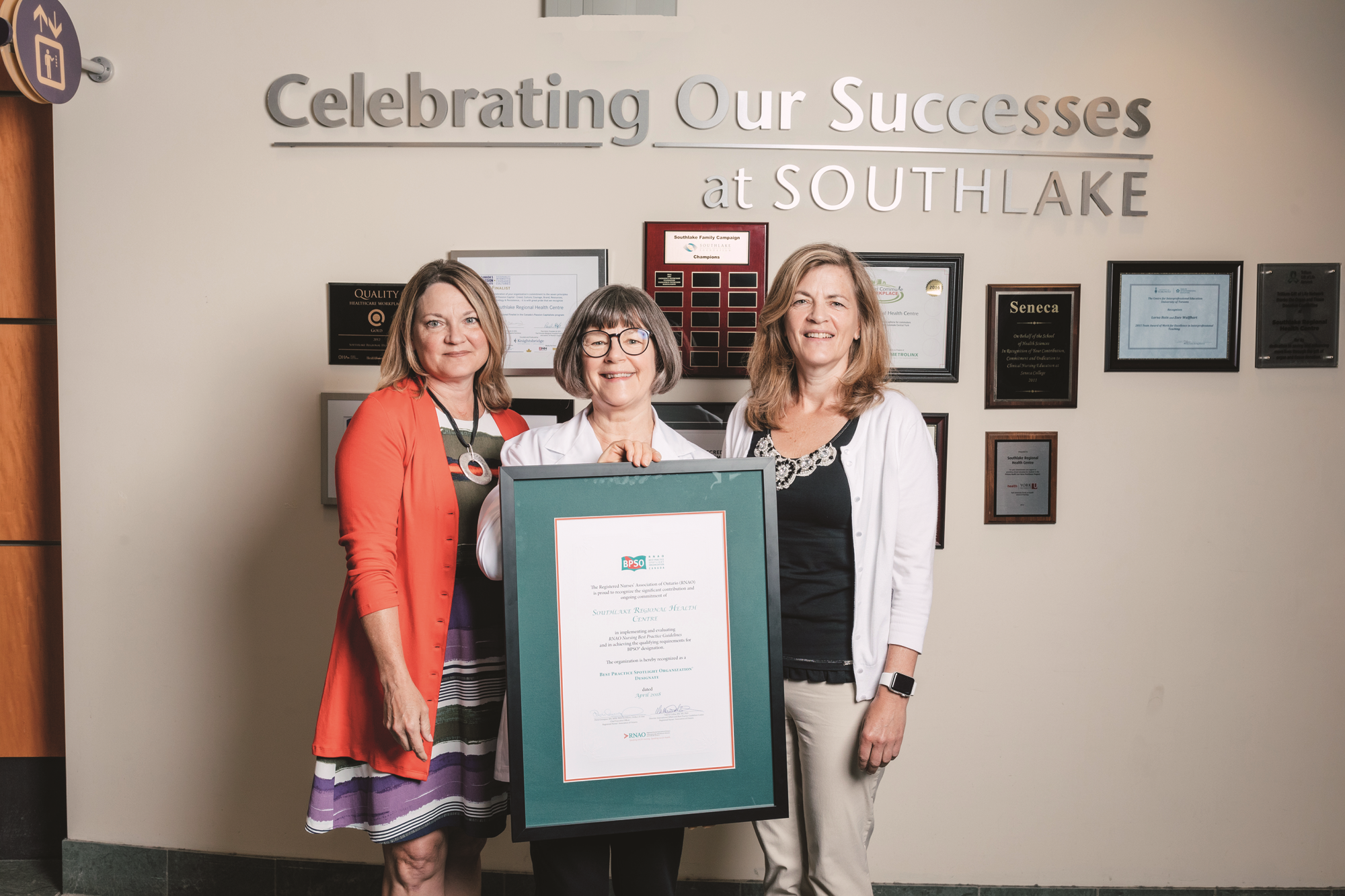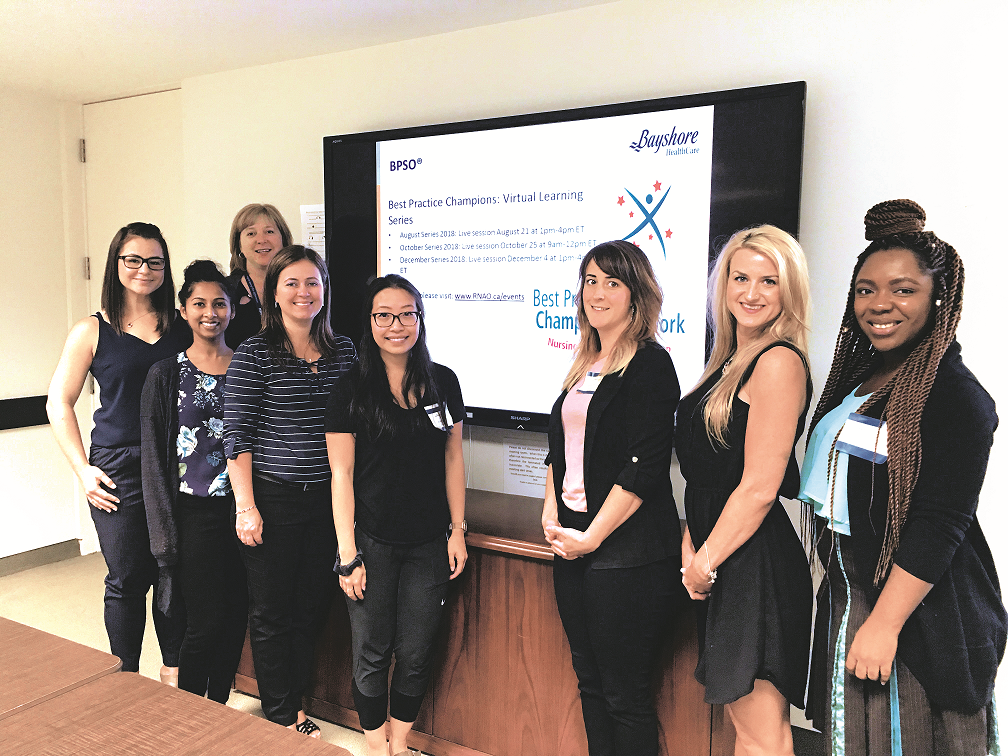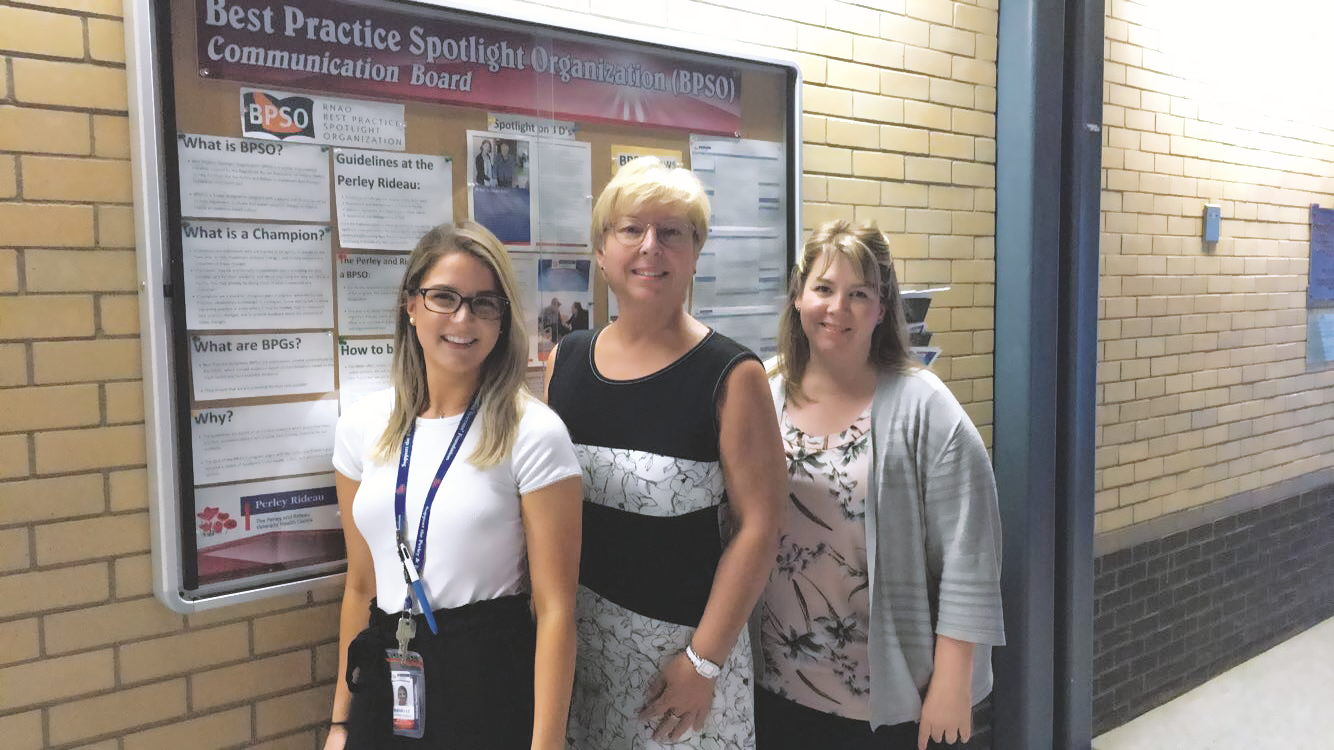
the BPSO program supports challenges in any sector striving for excellence through evidence.
Every health sector faces unique nursing challenges, but there’s one strategy that supports best practices unconditionally and spans them all: RNAO’s Best Practice Spotlight Organization (BPSO) program.
While earning BPSO designation gives organizations a leg up within their sector– enabling them to be leading examples in evidence-based care – it also helps them to overcome sector-specific challenges, whether that’s the lack of resources plaguing long-term care (LTC), the need to boost transparency and client self-management in home care, the challenges of engaging diverse practitioners in public health, or the struggle to support the fast-paced and increasingly complex patient population in acute care.
Being a BPSO impacts the bottom line through improved health outcomes. And it can also have enormous business perks. As Michelle DiEmanuele, CEO for Trillium Health Partners, says: being a BPSO “…didn’t just give us an opportunity to standardize best practices, it gave us an opportunity, with a proven methodology, to build a new culture in a (newly merging) organization. It got us where we needed to go faster, harmoniously, and gave us all something to rally for.” (see page 16)
Here’s how five diverse organizations in different sectors used their BPSO designation to achieve the same end: the implementation and sustainability of evidence-based practice…
Supporting the broad mandate of public health
Grey Bruce Health Unit serves more than 160,000 people, including members of First Nations reserves in the Grey Bruce area. With a mandate to deliver the highest quality public health services, evidence-informed practice was vital to the development of all strategies, says RN and chief nursing officer (CNO) Sarah Ellis. The decision to become a BPSO in 2012 also aligned perfectly with the organization’s intention to become accredited, she adds.
But Grey Bruce faced one big challenge over its three-year pre-designation period: getting all staff to fully embrace the culture change. “It’s taken us the past five years to get everyone to see (the change) not as an add-on but as a way to do our work,” says Ellis. That’s because the health unit’s many diverse practitioners – from health inspectors to dietitians to nurses – were struggling to see how best practices could actually work in a public health setting.
“The turning point was when staff began to see the outcomes of using the client-centred care (BPG),” says Ellis. As staff in different specialties implemented it, they grew to see the importance of knowing who the client is, she explains. For a public health inspector, for example, the client could be a restaurant owner.
“Traditionally, they are more regulatory-focused, but after implementing that BPG, there was a change in how (inspectors) work to ensure that while a restaurant might not pass an inspection, the owner feels respected.”
Over the past five years, staff has learned how to implement five BPGs in addition to client-centred care. They focus on childhood obesity, breastfeeding, postpartum mood disorder, substance use and falls, and stretch across the broad spectrum of public health capacities. “We developed internal working groups across program areas from dental to sexual health to Healthy Babies Healthy Children, to determine what screening tools could work for each,” says Ellis, adding the health unit also mobilized the community around important best practice issues, such as hosting RNAO substance-use workshops.
While measurement of the impact of BPGs in public health is a challenge, Ellis says that becoming a BPSO “jump-started” the journey towards its goal of being accountable and in a better position to report on outcomes. “It really set a template for how to incorporate a culture in public heath,” says Ellis, who doesn’t believe it would have achieved “exemplary” accreditation status without achieving its designation as a BPSO.
Not only did the health unit achieve its designation, but the increase in staff confidence is abundant, Ellis says. “Once staff became champions for best practice, it really allowed them to take on leadership roles and gain confidence in their skills and abilities…and helped them grow professionally. (Becoming a BPSO) is a great experience. It takes a lot of work and education, but it ultimately puts public health in a better place.”
Inspiring innovation in acute care
Southlake Regional Health Centre, a 400-bed hospital, has implemented more than 10 BPGs since becoming a pre-designate in 2015 (it achieved designation in April). How did it accomplish this feat in the fast-paced world of acute care?
“One key to our success was to embed a BPSO leader early on, who was seen as credible in our organization,” says RN Annette Jones, vice president, patient experience, and CNO. That helped boost commitment off the bat, and led to the recruitment of 17 per cent of staff into BPG champion roles. New nurse hires were also made fully aware of the BPSO initiative, and to ensure there was never a gap in leadership, two co-leads were identified for every BPG implementation, adds Jones.
The outcomes have been phenomenal. For example, the implementation of the delirium, dementia and depression (3Ds) BPG was so successful on one unit, the entire organization embraced it. Back in 2013, pressure injuries were occurring in over 20 per cent of patients. Post-BPG implementation, they are down to 1.9 per cent, says Jones. “Nurses can own and be very proud of the outcome of the wound assessment BPG,” she says. Also, after implementing the care transitions BPG, there’s been a 40 per cent decrease in missing information and errors on patient transfer documentation.
According to Arden Krystal, an RN and Southlake’s president and CEO, the greatest impact Southlake has experienced from being a BPSO is the boost to staff confidence, which allows staff to innovate. Jones adds that she can cite many examples of creative initiative among staff, such as nurses applying ostomy best practices across the full continuum of care, from pre- to post-op.
“In acute care…nurses are often dealing with varying levels of acuity and an aging population,” says Jones. Guidelines “…provide nurses with first-hand information about best practice, and with that in mind, they are encouraged to take the initiative and be creative.”
Staff is experiencing a greater sense of satisfaction as a result, adds Krystal. “And we know that staff satisfaction has a significant impact on the patient experience.”
Enabling empowered home care
Bayshore HealthCare is Canada’s largest provider of home and community health-care services, with more than 12,000 staff members providing care to over 200,000 clients at more than 100 locations, including home care offices, pharmacies and infusion clinics. The move to become a BPSO was brought to management by RN and CNO Holly Quinn in 2012. The organization is now in its second designation period (2017-2019) with more than 10 BPGs already implemented or underway.
Quinn says the strong credibility of the BPSO program and RNAO’s BPGs went a long way in her quest for senior management buy-in. So did her efforts to show how BPGs could accelerate or augment the organization’s strategic priorities, including accountable care.
“That way it wasn’t seen as something brand new, but rather an enabler,” she explains.
Zoom in closer on daily practice, and Quinn knew that being a BPSO would allow her to explore expertise across sectors, and draw on that expertise to empower caregivers and family members toward self-care in the home. “Unlike acute and long-term care, we are not under our clients’ roofs 24/7,” she explains. “Clients can be following a protocol well in hospital…then not at home. Our role as guests in their home involves a lot more influence and teaching. The more engaged a client is in their own care, the better the outcome.”
Best practices are ideal for giving nurses and other professionals the evidence or “backing” they need to negotiate on behalf of clients, whether that’s with physicians, caregivers or family, Quinn adds. It “…supports nurses who don’t have time to go to the literature. They know the expert literature reviews have been conducted.”
The push for ‘accountable care’ can’t be underestimated in home care either, says Quinn. Thanks to its BPSO status, Bayshore’s business leaders can see progress. “There is far more transparency with evidence-based practice,” she says. “From a leadership perspective, that allows (business leaders) to speak more confidently when demonstrating quality of care to funders. It gives us more credibility that we are a part of a validation program. From a clinical perspective, it gives us confidence to support and teach staff. And from a patient perspective, they are getting better treatment at home.”
Igniting self-starters in long-term care (LTC)
Ottawa’s Perley and Rideau Veterans’ Health Centre is a 450-bed home that jumped at RNAO’s 2016 call for BPSO proposals to LTC. “We wanted to be at the forefront and were focused on quality improvement, evidence-based practice, and the goal of reducing variance in care,” says Doris Jenkins, director of nursing. “Having a template or blueprint for action, like that which is offered in the BPSO program, was key.”
Jennifer Plant, the home’s director of clinical practice and co-BPSO lead, points out that LTC struggles with less resources and knowledge to share within. She says the BPSO structure helps with best practice implementation, as well as tools to help navigate the process, such as a BPSO coach. “That’s important,” Plant says. “Nothing is more frustrating than reinventing the wheel when a fantastic job is already being done.”
Indeed, the knowledge sharing among LTC BPSOs has turned out to be invaluable to Perley Rideau. In its work to implement the falls BPG, staff struggled with an existing and very time-consuming three-step documentation process. Another LTC BPSO had figured out how to document in one place, says Danielle Charbonneau, an RPN and BPSO liaison. Leveraging this kind of time-saving approach is vital in a sector with fewer registered nurses than other sectors and limited resources to build the long-term relationships residents need, she notes.
“Today, walking the hallway, you’d be hard-pressed to find someone who does not know about our BPSO work,” says Plant, suggesting a culture shift is taking root. Jenkins says that since they added BPSO champion as a preferred attribute in job descriptions, staff are seeking out training on their own. “We’re seeing them direct and own their learning, which is a huge response, especially in our sector,” says Jenkins. Staff is “…building towards a career, not a job, which is vital progress for long-term care, where residents come for their last stage of care in life and where it is their home.”
In addition to falls, the home has implemented BPGs related to pressure injury, pain management, and delirium, dementia and depression. Plant says they are seeing improvement in outcomes across the board. “We are seeing a reduction in residents who have pain. And some of that is down to standardizing the way we assess pain.”
Jenkins and Plant emphasize there is a need for more BPSO designates in LTC, where acuity levels are really changing (they are going up), even compared to a few years ago. “They are much frailer and have complex needs,” says Plant. “When you are working as a BPSO, you can have a voice at the table when improvements are being discussed.”
Perley Rideau aspires to be a centre of excellence in frailty informed care, Jenkins adds. “We think through this work, and our partnerships and collaborations, we will get there.”
The spark that ignited RNAO’s proposal to develop the BPG program came from its CEO Doris Grinspun’s expertise in evidence-based practice and her experience leading a project of this nature for the World Health Organization (WHO). The BPG program was a visionary answer to a government recommendation (in Good Nursing, Good Health: An Investment for the 21st Century (1999)) to establish clinical models in practice environments to allow nurses to gain expertise in clinical areas.
The BPG program was launched in 1998 by RNAO and Ontario’s health ministry, under the leadership of then health minister Elizabeth Witmer, who saw as much potential in BPGs as RNAO did. The program has enjoyed the strong support and accolades by consecutive governments ever since. Today, the BPG program and Ontario’s nursing leadership are known the world over.




